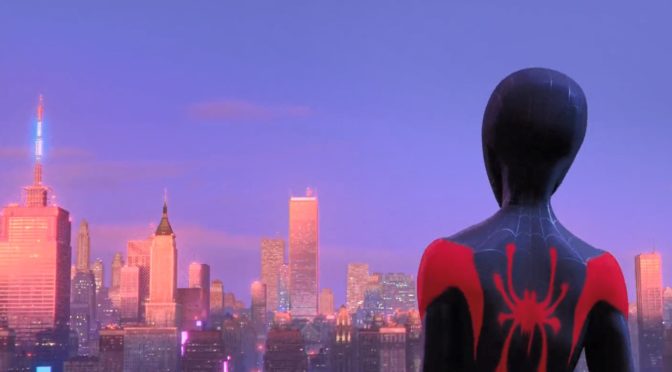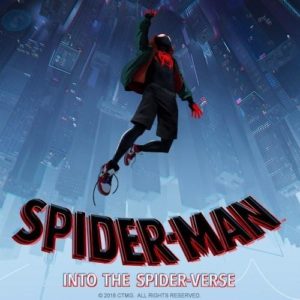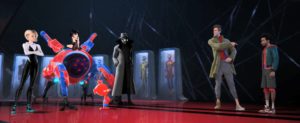Coming into 2018, reboots and sequels felt like the last things we needed. After two crisis-packed years full of rape scandals and xenophobic uproar, the culture was in dire need of something original and fresh to wash the acridness out of its mouth. We needed exciting, new stories. We needed to find in the movies the joyful, creative enthusiasm that felt so scarce in the outside world. The last thing filmgoers needed was more of the same. And, dear God, if you had asked me on January 1, 2018 to name the single thing American cinema needed least, I probably would have said, “Another Spider-Man movie.” With no disrespect intended to 2017’s very good Spider-Man: Homecoming, our culture has hit peak Spider-Man fatigue. Since 2001, the popular comic book hero has had no fewer than eight films to himself. If you throw in the two Avengers films he appears in, that figure climbs into the double digits. Spider-Man: Into the Spider-Verse really should have been the absolute last thing we needed. But, as I noted in my review of Paddington 2, sometimes we can be bad judges of what we need in films. And, as I noted in my review of A Star Is Born, 2018 had a way of taking old, overplayed stories and making them feel new again. So, for the record, this is my third 2018 film review to double as a mea culpa for my faulty film assumptions and the year’s third reminder that even the most tried and true properties can be vital, energetic, and essential when approached with wit, insight, and a palpable love for the story. Spider-Man: Into the Spider-Verse is not just an astonishingly wonderful animated reboot of this old franchise, but also a lively, intelligent meta discourse about why we like to reboot things. Why societies like to take certain stories, revise them, and retell them. I still maintain that we are nearing critical levels of super hero saturation, but Spider-Man: Into the Spider-Verse is the exception that recontextualizes the rule. It is about why we love to think about heroes and where we see ourselves in those narratives.
Spider-Man: Into the Spider-Verse starts with what will become a recurring bit. A version of Spider-Man catches us up on the essentials of the Spider-Man mythos. The opening narration comes courtesy of the Spider-Man we all know and love, Peter Parker. A bookish teenager, in love with his friend Mary Jane Watson, who attains super powers from a spider bite, loses his Uncle Ben, and dedicates himself to a life keeping New York City safe from criminals. Peter Parker is the official Spider-Man of this universe; what appears to be our universe. However, while Peter Parker takes us into the film, Spider-Man: Into the Spider-Verse is not his story. The film is instead the story of young Miles Morales, an Afro-Latino teenager living in New York City. Miles’ father Jeff (Bryan Tyree Henry, who had a banner year with brilliant work in If Beale Street Could Talk, Widows, and television’s Atlanta) is a brusquely endearing police officer with some strong negative opinions on Spider-Man, who he regards as a reckless vigilante. Miles has a loving but testy relationship with his father. Some of that testiness can be chalked up to general teenage malaise and some of it is the fact that Jeff is forcing Miles to attend a ritzy boarding school uptown instead of the public school in his own neighborhood. Like most teenagers, Miles is wrestling with his identity as an adolescent. He is also figuring out who he is as a member of two different minority cultures. Miles feels most at ease with his father’s estranged brother, Aaron (Mahershala Ali, having a very good year), who places less pressure on him and who is more encouraging of Miles’ true passion: street art. One night, Uncle Aaron takes Miles to an abandoned subway station to throw up some graffiti. As he is finishing his art, Miles is bitten by the fated spider, which gives him superpowers. At this point, we think we know the rest, but this is where the film expands in unexpected directions. When Miles returns to the subway station to look around, he finds Peter Parker engaged in a heated battle with Kingpin (voiced with deadpan Brooklyn brutishness by Live Schreiber), a wealthy businessman and supervillain who wants to open a portal to other dimensions so he can be reunited with his tragically deceased wife and child. In the first of many breaks from the standard narrative track we think we are on, Peter Parker is killed by Kingpin and Miles flees in terror. Before he dies, he tasks Miles with making sure Kingpin does not complete his mission, which would annihilate all of New York City. For better or worse, Miles is now his universe’s Spider-Man and he is confused and terrified about how to assume the mantle. As luck would have it, the opening of all those dimensions has sucked other versions of Spider-Man into Miles’ version of New York City, which allows Miles to seek help from an alternate Spider-Man, Peter B. Parker (a hilarious and surprisingly poignant voice performance from New Girl’s Jake Johnson). As misfortune would have it, Peter B. Parker is something of a trainwreck. Saggy, broke, and recently divorced from his universe’s Mary Jane, he is truly the John Q. Adams to Peter Parker’s John Adams. However, in spite of his paunchy appearance, Peter B. Parker gradually becomes an engaged and capable mentor to Miles and Miles helps Peter remember the motivated, inspiring man he used to be. Together with four other versions of the character, including Spider-Girl and an incorrigible cartoon pig named Spider-Ham (the always very funny John Mulaney), they must prevent Kingpin and a female Doc Ock (a marvelously fun and nuanced turn from the indispensable Kathryn Hahn) from reopening the portal and sucking New York City into nothingness. Spider-Man: Into the Spider-Verse is directed by Bob Persichetti, Peter Ramsey (Rise of the Guardians), and Rodney Rothman, three relatively young animation directors. They deserve all the credit in the world for this tremendous work, but the big celebrity of this creative team is co-writer Phil Lord, one half of the terrific Lord-Miller directing team. Lord and his partner, Chris Miller, brought us The Lego Movie and the 21 Jump Street cinematic reboot, two films that could have been lazy and overly commercial but turned out to be vivacious and irrepressibly funny instead. What Lord understands is how to lean into formula in ways that both mine it for comedy and lovingly own the tropes. The typical Lord-Miller film puts familiar cinematic stereotype in a fond headlock. As a film that flies fearlessly in the face of the overly familiar, Spider-Man: Into the Spider-Verse has Phil Lord’s comedic stamp all over it. It is one of the most consistently hilarious films of 2018 or any other year. However, what makes it better than anything he has done before, even the fantastic Lego Movie, is the dexterity Lord shows for balancing humor with rich pathos. Spider-Verse turns the 21st century’s seventh Spider-Man film into one of the most perfectly complete, emotionally fulfilling movie experiences of the year.
Spider-Man: Into the Spider-Verse’s script has all the beautifully zippy confidence of Spidey himself, but that only accounts for a portion of what makes it so winning and exhilarating. It is also a kaleidoscope of delirious, discombobulating color. I don’t know that I can name a single film from 2018 that was more delightful to just sit and look at. Scenes are painted in dazzlingly bold primary colors. The film’s version of New York City vibrates and twitches with nervous energy and possibility, like a hundred different dream versions of itself. Even that most troubled element of most Marvel-based films, the final climactic battle, feels gripping here. All of Spider-Verse’s many inspired elements are enriched and complemented by its ecstatically innovative animation. It cycles through a dizzying array of styles, as if to underline the film’s idea that there are hundreds of personal, idiosyncratic ways to tell the same story. Spider-Man: Into the Spider-Verse also sets a new high watermark in making a comic book film that feels like a comic book in all the best ways. The look of the film shifts with the tone and stakes of individual scenes. Characters appear in panels. Words flash across the screen. And all of it looks fun and glorious The upside down shot of Miles Morales seeming to dive upward toward the New York City skyline is one of 2018’s most arresting and instantly iconic images. More than just evoking the look of comics, Spider-Man: Into the Spider-Verse is the one film in its franchise to fully capture how disorienting, liberating and thrilling it would feel to actually be Spider-Man. That’s true during blisteringly energetic fight scenes, but it’s just as true in moments of calm. In one scene, Peter Parker has walked up the side of a building to the roof and Miles is standing sideways on the building’s façade, looking up at him. We cut to Miles’ point of view and we see the roof ledge and the sky above it and I gasped. It’s an intimate dialogue scene, but that shot thrilled me. When you’re Spider-Man, even your downtime involves defying gravity. Spider-Man: Into the Spider-Verse is an impossibly fun, kinetic whirlwind of a film; the rare example of a comic book movie utilizing the full possibilities of cinema to tell its story. At the end of the day, it forces me to use a word that the truly sober-minded critic would resist. But, when I reflect on how I felt watching it, the most accurate word is just “cool”. Because holding your breath while grinning from ear to ear is cool. Because riding the world’s most hilarious, poignant, and socially conscious rollercoaster is cool. Because I know cool when it sends me hurtling from the tops of skyscrapers with wide eyes and a giggle fit.
Spider-Man: Into the Spider-Verse addresses the notion that the comic book movie has become predictable and stale and it reminds us that this genre still has boundless creative avenues to explore. It sees comics as a form with a distinctly communal kind of creative spirit. The beauty of comics and of animation in general is how much they allow for and encourage wild, limitless artistic expression. The style varies based on the artist interpreting the material and the familiar tropes and formulas serve as challenges to the artist’s imagination. The comic book has long been an art form where a wide variety of artists take turns telling the same story and the comic book film has become its own very collective cultural phenomenon. At this point, there can be little argument that it is the kind of movie seen and shared by the widest cross-section of the population. Spider-Man: Into the Spider-Verse is about the act of taking a very widely known, communal piece of art and reinvigorating it by making it your own. In that way, comics are also a lot like hip hop, a musical tradition that richly informs the film’s aesthetic and soundtracks its most pivotal scenes. In hip hop, as in comics, there is a joy that comes from taking old lines and classic beats (story and musical) and bringing them back in new forms. Old material recycled into new patterns and permutations. There is an art to taking something familiar and allowing it to mutate. Hip hop and comics can both be like a big cultural game of Telephone. In taking one of the most covered super hero origin stories out for another spin, Spider-Man: Into the Spider-Verse is accepting the noble challenge issued to every comic and hip hop artist. Many have played in this art form before you, but the good news is you have a wealth of tradition to draw on. What will you do with it? We get reboots and sequels every year, but Spider-Man: Into the Spider-Verse is something special: the super hero movie’s first remix.
The film is all about how many new directions and angles still remain in one of comics’ oldest narratives. But Spider-Verse also attains an extra level of pathos because it is about allowing new types of characters into those old narratives. For as long as we’ve had Spider-Man movies, we have never seen someone like Miles wear the mask before. Spider-Man: Into the Spider-Verse gives cinema its first non-white Spider-Man (not to mention its first Spider-Girl in the same film) and the decision pays off splendidly. Miles Morales is simply one of 2018’s richest characters: funny, kind, conflicted, and complex. In a film where picking the best voice performance could easily result in a six-way tie (a tie that doesn’t even include John Mulaney’s riotously funny, ahem, hamming), special notice has to go to Shameik Moore’s sensitive, note-perfect work as Miles. Representation for people of color on screen is an inherent good, regardless of the given film’s quality. But Spider-Man: Into the Spider-Verse is the kind of victory for diverse screen casting one really hopes to see. Forget my ever thinking this Spider-Man arc was too familiar. The addition of this nuanced, young Afro-Latino man into the narrative makes all the difference. I have swung through the air with a lot of Spider-Men. But swinging with Miles Morales was an honor and a genuine pleasure. This is an exciting, interesting, soulful character journey by any metric. A primetime role for a talented black actor that he proceeds to knock the ever-loving stuffing out of. I am happy and curious to follow this hero’s journey wherever it may go in the future. The most pleasantly surprising facet of Spider-Man: Into the Spider-Verse is that, for the first time in a long time, I don’t feel like I know where Spider-Man will go next.
To its list of accomplishments, there is one more we can add. Spider-Verse has what is, for me, far and away the best Stan Lee cameo in any Marvel film. The film isn’t even part of the Marvel Cinematic Universe, but the compliment stands. The cameo occurs when a distraught Miles Morales goes to a costume shop to buy a Spider-Man mask to wear in solidarity at Peter Parker’s funeral. He goes to pay and the cashier is Stan Lee. Miles asks what he should do if the mask doesn’t fit and Stan Lee gives him this inspiring bit of reassurance. “The mask always fits eventually.” It’s a great line about self-acceptance, coming of age, and learning to take personal responsibility, themes that are pivotal to the Spider-Man narrative. But then, having uttered this bit of wisdom, the old man points to the “No Refunds” sign behind him and flashes a toothy huckster’s grin. It’s everything to love and hate about these super hero movies all captured in one moment. Can comic book films be inspiring and inspired, capable of speaking eloquently to our loftiest aspirations and deepest fears? Yes, they can. Are they also an insanely profitable racket, a cunning ploy for our wallets that mercilessly mine our most fragile desires and insecurities? Yes, they are. My goodness though, the last thing we need is another comic book movie. But Spider-Man: Into the Spider-Verse is just plainly a great, great film. And those, we can never have enough of. Besides, there is a reason people are so drawn to these kinds of stories. And the chance to ponder those reasons, while backflipping over the Empire State Building, is pretty damned cool. There’s just no fighting it.















